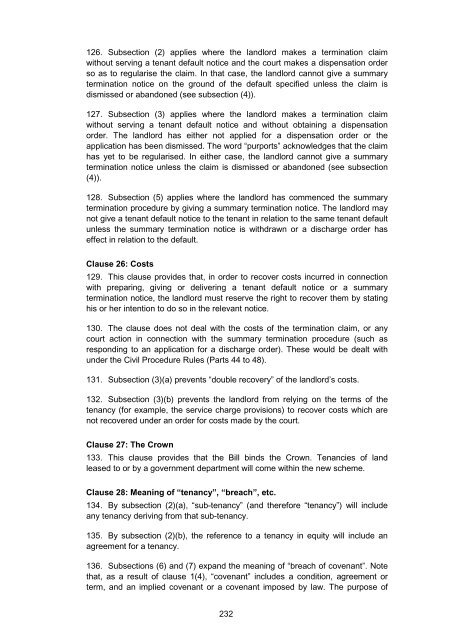Termination of Tenancies for Tenant Default - Law Commission
Termination of Tenancies for Tenant Default - Law Commission
Termination of Tenancies for Tenant Default - Law Commission
Create successful ePaper yourself
Turn your PDF publications into a flip-book with our unique Google optimized e-Paper software.
126. Subsection (2) applies where the landlord makes a termination claim<br />
without serving a tenant default notice and the court makes a dispensation order<br />
so as to regularise the claim. In that case, the landlord cannot give a summary<br />
termination notice on the ground <strong>of</strong> the default specified unless the claim is<br />
dismissed or abandoned (see subsection (4)).<br />
127. Subsection (3) applies where the landlord makes a termination claim<br />
without serving a tenant default notice and without obtaining a dispensation<br />
order. The landlord has either not applied <strong>for</strong> a dispensation order or the<br />
application has been dismissed. The word “purports” acknowledges that the claim<br />
has yet to be regularised. In either case, the landlord cannot give a summary<br />
termination notice unless the claim is dismissed or abandoned (see subsection<br />
(4)).<br />
128. Subsection (5) applies where the landlord has commenced the summary<br />
termination procedure by giving a summary termination notice. The landlord may<br />
not give a tenant default notice to the tenant in relation to the same tenant default<br />
unless the summary termination notice is withdrawn or a discharge order has<br />
effect in relation to the default.<br />
Clause 26: Costs<br />
129. This clause provides that, in order to recover costs incurred in connection<br />
with preparing, giving or delivering a tenant default notice or a summary<br />
termination notice, the landlord must reserve the right to recover them by stating<br />
his or her intention to do so in the relevant notice.<br />
130. The clause does not deal with the costs <strong>of</strong> the termination claim, or any<br />
court action in connection with the summary termination procedure (such as<br />
responding to an application <strong>for</strong> a discharge order). These would be dealt with<br />
under the Civil Procedure Rules (Parts 44 to 48).<br />
131. Subsection (3)(a) prevents “double recovery” <strong>of</strong> the landlord’s costs.<br />
132. Subsection (3)(b) prevents the landlord from relying on the terms <strong>of</strong> the<br />
tenancy (<strong>for</strong> example, the service charge provisions) to recover costs which are<br />
not recovered under an order <strong>for</strong> costs made by the court.<br />
Clause 27: The Crown<br />
133. This clause provides that the Bill binds the Crown. <strong>Tenancies</strong> <strong>of</strong> land<br />
leased to or by a government department will come within the new scheme.<br />
Clause 28: Meaning <strong>of</strong> “tenancy”, “breach”, etc.<br />
134. By subsection (2)(a), “sub-tenancy” (and there<strong>for</strong>e “tenancy”) will include<br />
any tenancy deriving from that sub-tenancy.<br />
135. By subsection (2)(b), the reference to a tenancy in equity will include an<br />
agreement <strong>for</strong> a tenancy.<br />
136. Subsections (6) and (7) expand the meaning <strong>of</strong> “breach <strong>of</strong> covenant”. Note<br />
that, as a result <strong>of</strong> clause 1(4), “covenant” includes a condition, agreement or<br />
term, and an implied covenant or a covenant imposed by law. The purpose <strong>of</strong><br />
232

















